Wednesday, July 28, 2010
 8:44 AM |
Why Can't I Own a Canadian?
8:44 AM |
Why Can't I Own a Canadian?
By Nancy MalletteIn her radio show, Dr. Laura Schlesinger said that, as an observant Orthodox Jew, homosexuality is an abomination according to Leviticus 18:22, and cannot be condoned under any circumstance.
The following response is an open letter to Dr. Laura, written by a U.S. man, and posted on the Internet. It's funny, as well as informative:

Dear Dr. Laura:
Thank you for doing so much to educate people regarding God's Law. I have learned a great deal from your show, and try to share that knowledge with as many people as I can. When someone tries to defend the homosexual lifestyle, for example, I simply remind them that Leviticus 18:22 clearly states it to be an abomination ... End of debate.
I do need some advice from you, however, regarding some other elements of God's Laws and how to follow them.
1. Leviticus 25:44 states that I may possess slaves, both male and female, provided they are from neighboring nations. A friend of mine claims that this applies to Mexicans, but not Canadians. Can you clarify? Why can't I own Canadians?
2. I would like to sell my daughter into slavery, as sanctioned in Exodus 21:7. In this day and age, what do you think would be a fair price for her?
3. I know that I am allowed no contact with a woman while she is in her period of Menstrual uncleanliness (Lev. 15: 19-24). The problem is how do I tell? I have tried asking, but most women take offense.
4. When I burn a bull on the altar as a sacrifice, I know it creates a pleasing odor for the Lord (Lev. 1:9). The problem is my neighbors. They claim the odor is not pleasing to them. Should I smite them?
5. I have a neighbor who insists on working on the Sabbath. Exodus 35:2 clearly states he should be put to death. Am I morally obligated to kill him myself, or should I ask the police to do it?
6. A friend of mine feels that even though eating shellfish is an abomination, Lev. 11:10, it is a lesser abomination than homosexuality. I don't agree. Can you settle this? Are there "degrees" of abomination?
7. Lev. 21:20 states that I may not approach the altar of God if I have a defect in my sight. I have to admit that I wear reading glasses. Does my vision have to be 20/20, or is there some wiggle-room here?
8. Most of my male friends get their hair trimmed, including the hair around their temples, even though this is expressly forbidden by Lev. 19:27. How should they die?
9. I know from Lev. 11:6-8 that touching the skin of a dead pig makes me unclean, but may I still play football if I wear gloves?
10. My uncle has a farm. He violates Lev.19:19 by planting two different crops in the same field, as does his wife by wearing garments made of two different kinds of thread (cotton/polyester blend). He also tends to curse and blaspheme a lot. Is it really necessary that we go to all the trouble of getting the whole town together to stone them? (Lev. 24:10-16). Couldn't we just burn them to death at a private family affair, like we do with people who sleep with their in-laws? (Lev. 20:14)
I know you have studied these things extensively and thus enjoy considerable expertise in such matters, so I'm confident you can help. Thank you again for reminding us that God's word is eternal and unchanging.
Your adoring fan.
James M. Kauffman, Ed.D.
Professor Emeritus, Department of Curriculum, Instruction, and Special Education
University of Virginia
P.S.It would be a damn shame if we couldn't own a Canadian.
ART: BIRD'S EYE VIEW BY STEVE WALKER
Labels: humor, queer, rants, religion
[1] This is Where You Bite the Sandwich
Tuesday, July 27, 2010
I don’t remember the last time I have felt this kind of sadness for this x number of days. It has been bothering me lately, because [1] none of the usual tricks are working, and [2] there seems to be no definite reason why I should go around my days masked in a frown.
I lie.
I
do know why I’m sad. And it infuriates me that something so unworthy, so despicably insignificant could be the reason for this melancholy.
I lie again.
It
is something worthy. And I should just stop lying that a thing could be so powerful it could move the very geography of my mental state. It causes utter madness, and I find myself perched on the precipice of so much want, of so much despair, and find that there is an urge to jump into that welcoming black hollow. How could a thing consume this much?
There goes another lie.
It is
not a thing. It is a face. A beautiful face. And in my dreams, it is next to me. It sees only me, and gazes with the bright observation of a beloved. But dreams are not real. Reality is harsh and sharp like shards of exploded glass, and scrapes its jagged edges on my skin, writing in the ink of my own blood its fierce judgment of how broken I am, and how accepting I am of that shattered state.
That one is not a lie.
Labels: life, love
[0] This is Where You Bite the Sandwich
Friday, July 23, 2010
I last saw her when I was a kid—pushing Grade Six, she quickly reminded me in that birdlike voice that suddenly seemed so very familiar. I guess that’s the way memory works—all of our past lies like a wide and sleeping country, submerged in all our every day forgetfulness, but tingles now and then to the right impulses. The woman named Bathsheba did not look the same—where was the slight young woman whom I used to call Tita Batch, who once took me to Siquijor on a whim, when I was still a wee little boy, which was my first introduction to that mystical place? Her tinkling voice brought me back.
It was what greeted me when she opened the door to her hotel room, in that glorified hospital that marks the southern tip that is the Boulevard. “Is this you? But you’re not a little boy anymore!” she said. I think I must have replied, with a smile: “Sorry, but I couldn’t stop growing up. No one could.”
My mother had brought me here, to this hotel, after endless text messages that day, asking me that my Tita Batch was asking for me. “Do you remember her?” she asked.
"Of course I remember her,” I said. “I still remember Siquijor.” My mind was suddenly running—there were quick slivers of thoughts that contained golden sunsets, a motorcycle ride around the island, an encounter with a strange nocturnal insect that gave me rashes for my remaining days in that island. But Bathsheba had apparently forgotten all of that, I quickly realized. “I brought you to Siquijor?” was what she said, disbelieving, her voice still tinkling in that familiar way. “I don’t remember that.”
It didn’t matter. I have long since accepted the fact that all of us accommodate our memories to a set of definite totems that we hope can sustain us in this mad scramble that is life. It’s what grownups do.
“What I remember most is a letter you sent me once,” she later said, “when you were still in Grade Six.”
“I sent you a letter?” This one I didn’t remember.
“Yes, when I was still working as a nurse in New York,” she said. “I still have that letter. It’s pasted in one of my albums. It was a really well-written letter, for somebody your age—and I still show it to friends, and I tell them, this boy here? He’s a writer now.”
“What did I say?”
“You told me that one day you would love to visit Disney World. It was your dream.”
“I did? It was?”
I vaguely remembered having a Disney phase in childhood. I had watched all the films—both live action and animation, had drawn all the zany characters in hundreds of sketchpads, had collected all the brochures about the Happiest Place on Earth. I could still scrawl out, until today, Disney’s famous signature in one go, and without batting an eyelash; Mickey Mouse’s face is just a sketch away from any pencil.
So I told myself,
she is telling the truth.
“And did you know that I live in Orlando now? In Florida,” she said. “So you can visit me any time, and fulfill that dream.” She laughed. I smiled, unbelievably non-committal.
But the years have taught me detachment, even from silly childhood dreams.
Soon, she was talking with mother about me—how I was like as a kid, for example. It was then that I caught a glimpse of myself, my past at the very least, as others saw me. I was that needful kid? They called it something else.
“Parayigon man na siya sa una,” mother said.
Parayigon. The needful charm of little children. I shook my head a little, just enough that they wouldn’t see me.
I don’t remember much how the rest of that evening went. Only that it ended. That she had gone down with us in the elevator to our waiting car. That we had said our goodbyes, and she had said, “I hope to see you when you get to the U.S.,” and that I had nodded.
I remembered having this persistent thought though: that the past is an uncomfortable place of such aching familiarity—and there is a reason why it feels like a different country, why it’s perfectly behind us. The car moved. It was already late at night. I looked at the silent witness of stars, and felt the tug of the present and the future suddenly colliding.
I’m here, I told myself.
Labels: family, friends, life, memories
[0] This is Where You Bite the Sandwich
Thursday, July 22, 2010
 7:46 PM |
Amihan Explores Femininity and Power in New Art Exhibit at Silliman
7:46 PM |
Amihan Explores Femininity and Power in New Art Exhibit at Silliman
The exhibit title evokes power and femininity; it paraphrases a chess term about how a pawn journeys across the length of a board to become a queen. Amihan, the eldest daughter of the Jumalon family of painters, shows us glimpses of her own journey in becoming an artist and a mother in the above-titled art show. It opens at the Luce Auditorium Foyer Gallery at Silliman University in Dumaguete on
24 July 2010 at 5:30 P.M.
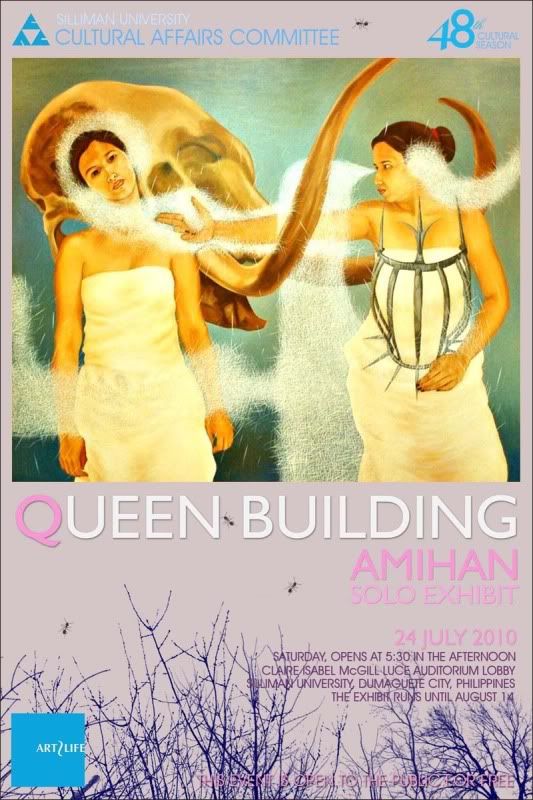
The exhibit is part of the 48th cultural season of the Silliman University Cultural Affairs Committee.
“Being a mother and an artist is like walking a tightrope. If I fall, something breaks. You can’t run, you don’t have the time. So you tread slowly and allow these roles to serve as your balance beam,” says the artist. “
Queen Building is a visual, surreal chronicle about undertaking and maintaining these roles.”

The works in this coming exhibit all feature female figures, which have been Amihan’s primary subjects all throughout her career as a visual artist. Some are grim personas born out of the artist’s struggles to fuse being a mother and an artist in the years she has been largely absent from the art scene. Some are painted almost like mythological figures; dream symbols that evoke a particular aspect of women’s experiences. And some are virtually self-portraits, the artist recreating and discovering facets of herself.
Thus, on ‘Iron Maiden’ (acrylic on canvas), we see the artist’s implacable likeness personifying a medieval torture device while another figure crawls out of its dark, womb-like recess. The monochromatic painting manages to evoke both aggression and femininity, qualities that can be found in the artist’s earlier paintings.
In ‘Lovers’ (acrylic on canvas), we see the artist recreating herself once again, this time as two copies of herself, setting them up in mischievous poses while a huge mastodon skull dominates the background.
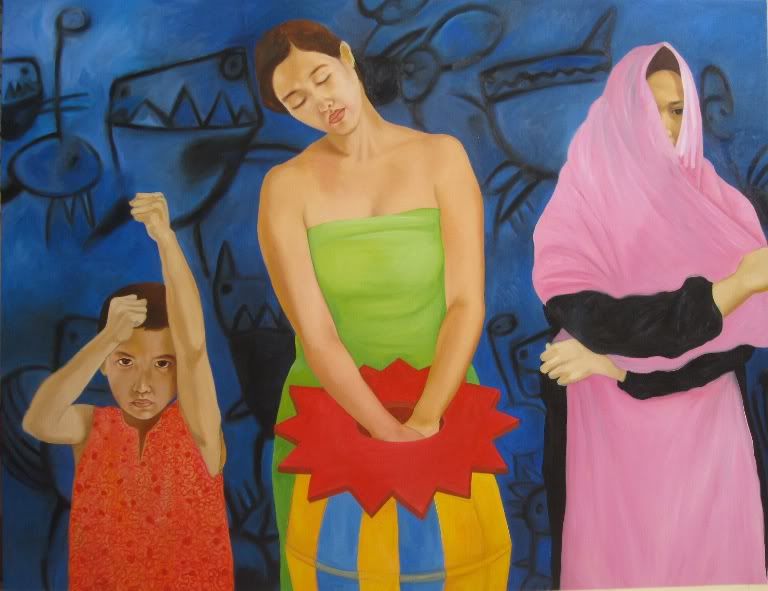
We see another figure with her likeness in ‘Magician’ (acrylic on canvas), which provides a colorful counterpoint, not only to the more muted approach of the other works, but to the mother-and-child genre paintings. This large-scale work features a portrait of the artist with her hands inside a barrel, her young son, and another hooded female figure. Naïve stick figures of monsters (which her son doodled) dance in the background.
The personal becomes the universal. “Queen building” is a reflection of the multitude of roles and personas worn by women. It is in these explorations of self as archetypal female subjects that Amihan’s work shines.
The exhibit runs until August 14, and is open to the public. For more information, please call (034) 422-6002 loc. 520 or 09173235953.
(Bendix Fernandez for the Silliman University Cultural Affairs Committee)Labels: art and culture, cultural affairs committee, dumaguete, negros, silliman
[0] This is Where You Bite the Sandwich
Saturday, July 17, 2010
 1:48 AM |
Eating Pink Halo-Halo
1:48 AM |
Eating Pink Halo-Halo
Looking back, sitting there outside Dencio’s in Harbor Square, a stone’s throw away from the Cultural Center of the Philippines, it felt good to be just a mere spectator for once. Because last year, in the Cinemalaya, I was part of its Film Congress as a representative of the filmmaking scene in Dumaguete—and it was the usual part work, part pleasure things. But this year, it was all pure pleasure, pure moviegoing relaxation.
I was, to cite an example, relaxing, taking the night in, and drinking San Mig Lite outside Dencio's with the screenwriter Armando Lao.
Earlier that weekend, I had planed in from Dumaguete just for the Cinemalaya and to process my U.S. visa for my fellowship in the International Writers Program in Iowa. It was the start of a good weekend, and the film festival—the most acclaimed of its kind this part of the Philippines—had just began. People I know from film were suddenly everywhere. I’ve always loved this kind of Manila trips that I take; they are always occasions for instant reunions. People you only see in Facebook are suddenly there in front of you, in the flesh. And the hugs and the handshakes are constant, they fly everywhere.
That Saturday, I had gone to the launch of three books being put out by newbie publisher Gilbert Sape of Grey Matter Publishing—two of them by good friends of mine, people I “hang” out with in the blogging world. There’s
Dear Migs: Letters to the Manila Gay Guy by “Migs” and edited by
Philippine Daily Inquirer theater critic Gibbs Cadiz, and then there’s
The Wet Book: Stories From the Bathhouse by Joel Macaventa, alias McVie, and edited by the film producer and writer Raymond Lee. The launch was in Quezon City—and the place, which was the studio of the photographer Ian Felix Alquiros, was packed. I met old friends and new—the writers J. Neil Garcia, Moki Villegas, and Ronald Baytan, the visual artist Daniel Palma Tayoma, the director Jade Castro of
Endo fame, the TV broadcasters RG Cruz and Ryan Edward Chua, among many others. Hugs, handshakes. I saw Carlo Vergara, the genius behind
ZsaZsa Zaturnnah—and we both exclaimed with such delight: “Finally!” Another round of hugs.
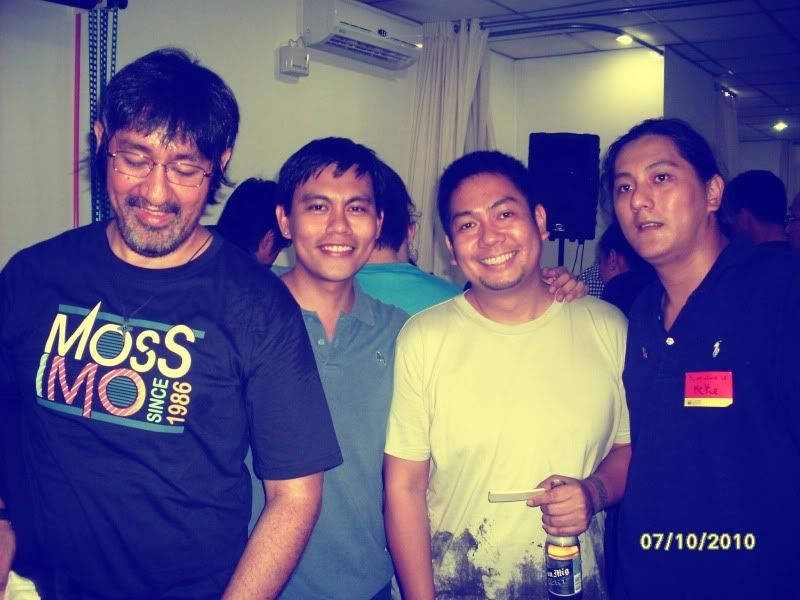
Then it was back to Manila, to the lovely Syquia Building near Malate, where I dined on varieties of cheese and wine and cold cuts in the beautiful apartment of the director Butch Perez.
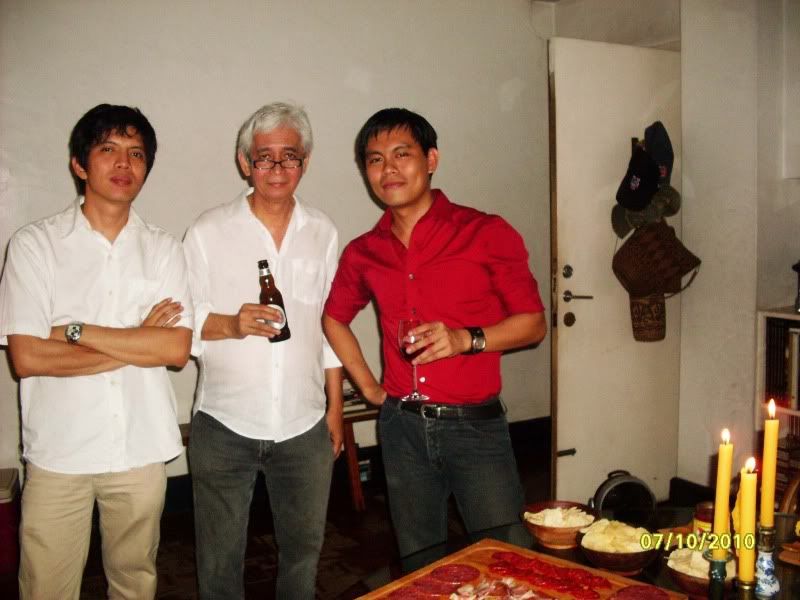

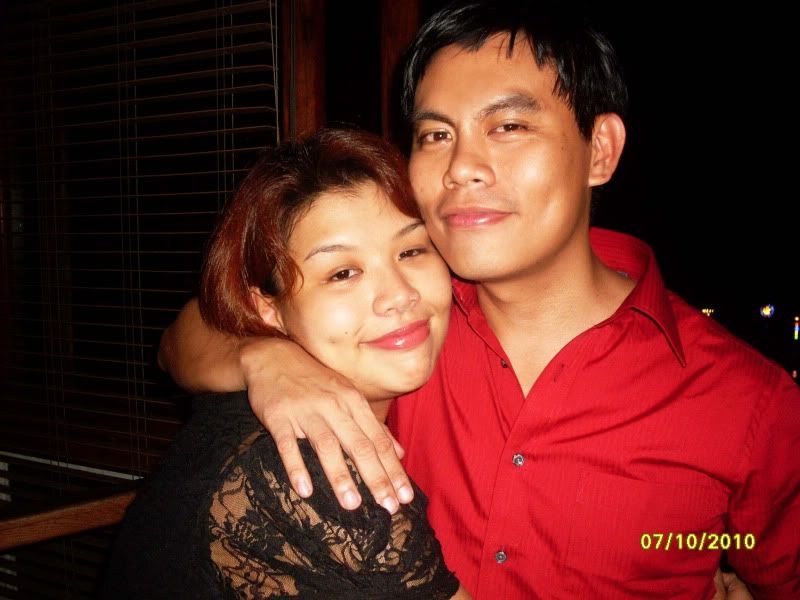

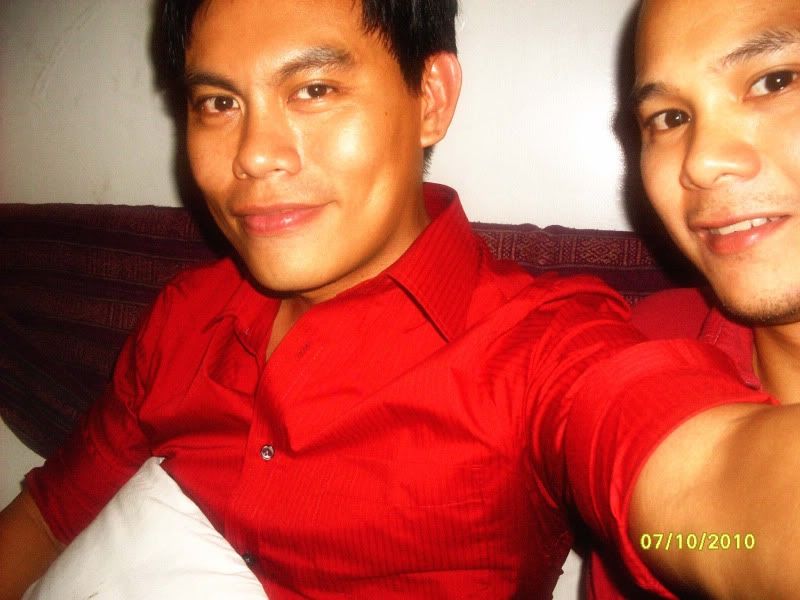
Butch had a great view of the Manila Bay, and he entertained us—the writers Ginny Mata, Kit Kwe, Marc Escalona Gaba, and Kris Lacaba—to the disco beat of David Byrne and Fatboy Slim’s Imelda musical
Here Lies Love. We talked about Iowa winters and Negrense Chinese matriarchs with recipes and the lives and loves of people we know. The usual stuff.
On Sunday, there was the late night beer with Bing Lao. “You are a god,” I had told Bing earlier—a compliment he must get a lot. This is the screenplay writer, after all, of all those acclaimed movies, from Jeffrey Jeturian’s
Pila Balde and
Sana Pag-ibig Na and
Kubrador to Brillante Mendoza’s
Serbis and
Kinatay, those controversial Cannes Film Festival winners that has brought to the world a concept of film writing that is gaining traction the way the Danish had with its Dogme 95. In Bing’s case, it is the Found Story concept that is central to the style of such emerging filmmakers as Francis X. Pasion, Jay Altarejos, Jeturian, and Mendoza, among others.
He had been going around the CCP complex among the throng that constituted the devotees of the Cinemalaya Film Festival, filming Mark Xander Fabillar (who has a supporting turn in
Pink Halo-Halo) and Jay Altarejos as they went about their way welcoming people to the gala premiere of Jay’s latest film. It was going to be a kind of pseudo-documentary, and I was in the middle of the shoot. Later, after the premiere, the beer came, and the talk and banter.

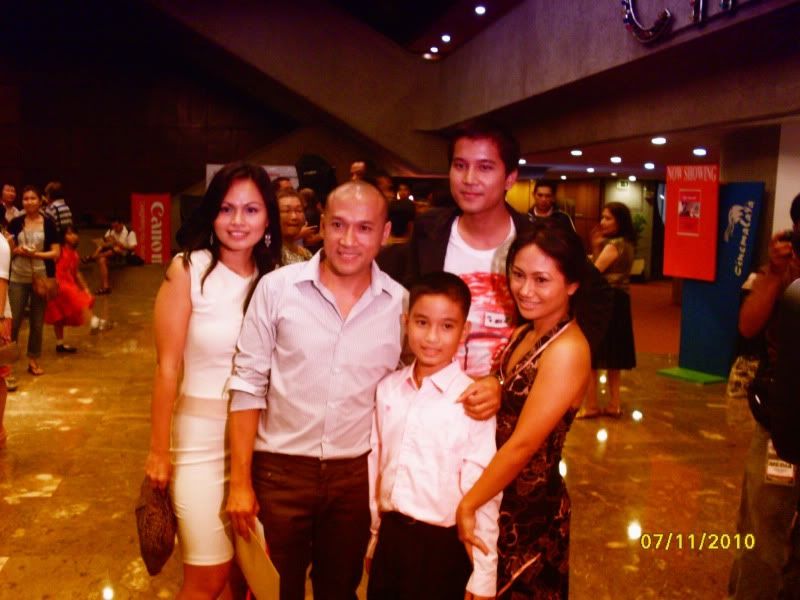
People came and went. Joel Torre passed by. Raymond Lee stopped by, and I told him, “When are you going to finish
Patayin sa Shokot si Remington? I can’t wait to see it
na.” He laughed and did a short curtsy. That was it. The director Raya Martin also passed by, sporting a new look of cropped hair. “When did you come back?” I asked him, “I thought you were holed up somewhere in Paris or wherever.” We hugged, and he said, “I’m just here, just lying low.” I laughed.
The female lead of
Halo-Halo, the wonderful Angeli Bayani, soon joined us—and it was the start of the marathon to a long, beautiful night where everybody pitched in to share “talk” and industry tidbits, all told in gestures and enunciations of grand drama. You know, theater and film people.
I called her the new Meryl Streep. She blushed. She was transcendent in
Pink Halo-Halo, a film of such beautiful simplicity that I turned to Jay, who was sitting beside me in the Tanghalang Nicanor Abelardo, and said, “I hate you.
Pinaiyak mo ako.” And I thought of that, and was bemused by how far Jay had come—from the titillations of
Ang Lalake sa Parola and
Ang Lihim ni Antonio to the grit of
Ang Laro sa Buhay ni Juan to the heart of
Pink Halo-Halo. Because sometimes it’s hard when you find yourself put in a box by other people—and not allowed to be anything more. “
Hindi ka na bold gay films!” the magnificent Ed de los Santos Cabagnot had told him earlier, and broke into boisterous laughter.
We all laughed, too.
And that was it that weekend. Those nights. With Manila friends.
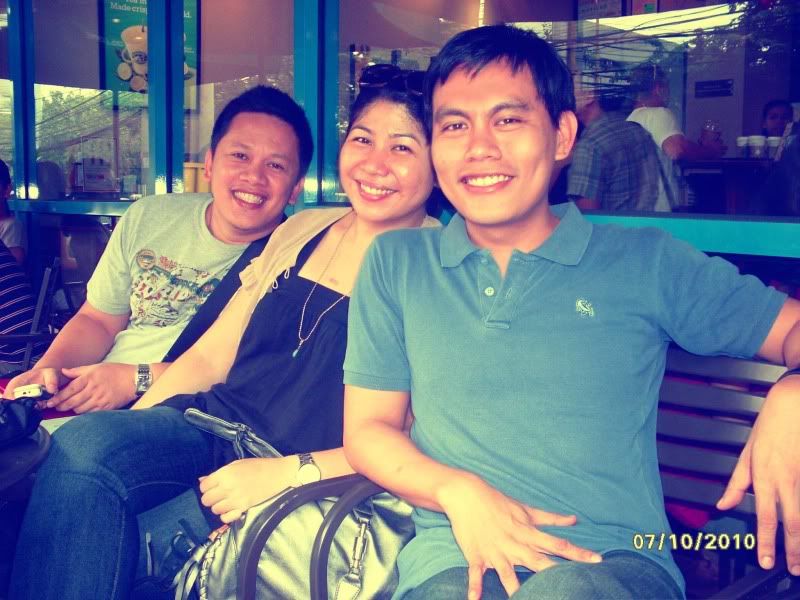
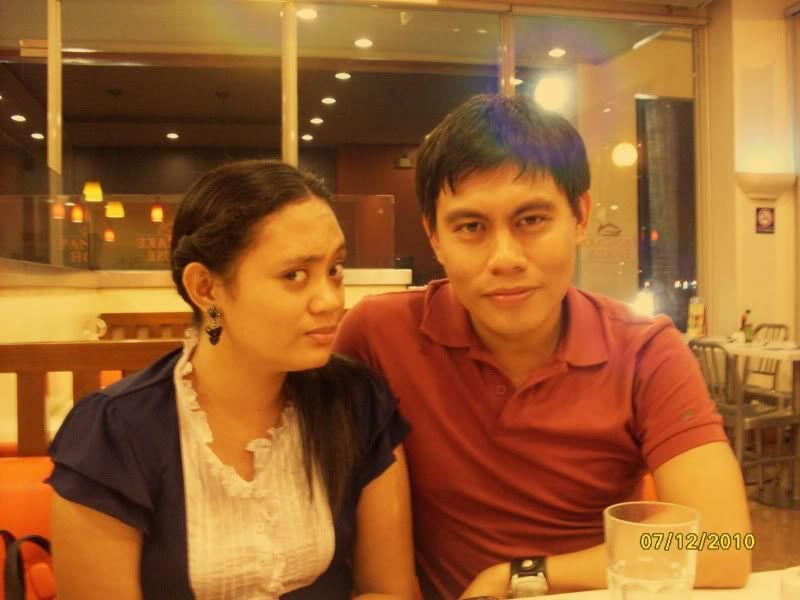
And then, two days later, I escaped Typhoon Basyang by minutes, and planed all the way back to my Negros town, where everything is quieter. Quiet, yes—but it has also become a reservoir of so much missing other people not here.
Labels: books, directors, film, friends, life, party, queer, travel, writers
[5] This is Where You Bite the Sandwich
Wednesday, July 14, 2010
 2:04 PM |
A Duet in Body and Imagination
2:04 PM |
A Duet in Body and Imagination
I have a love-hate relationship with performance art. When it’s good, it blows our minds and makes us reach deep within ourselves, asking questions about this and that. It transcends its inherent strangeness—
and all performance art is strange—and makes the familiar both unfamiliar and intimate at the same time.
But when it’s bad, you feel like a monkey’s uncle.
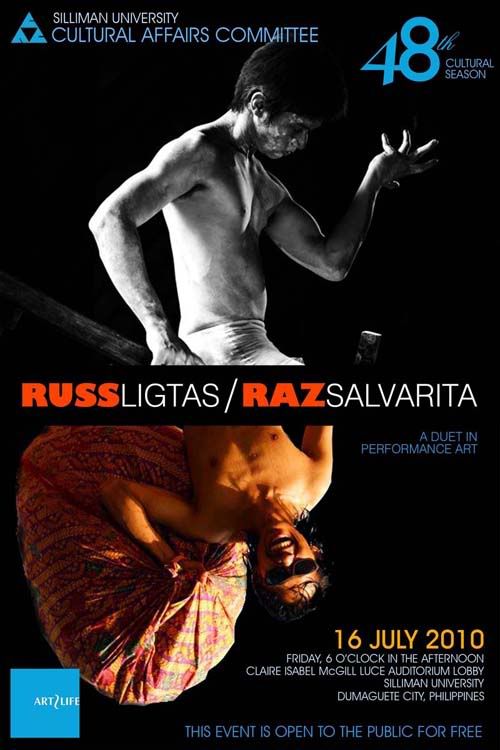
Once in Hayahay I had to sit through a turgid piece by some performance artist from Manila, whose work consisted of reading aloud to the microphone entries from the Webster’s Dictionary. It’s not that I didn’t get it: it was just a bad piece, a complete waste of time—and like the worst of junk art, it didn’t give us anything new. “If I wanted to get the definition of the word ‘ghastly,’ I’d be home and find my own dictionary,” I told my companion. “I didn’t have to come here all the way through the rain, with an order of beer.”
But all performance art always courts the tricky borders of ghastliness and transcendence. Some do it though with the command of the true artist. I know the writer Vim Nadera does his performances with much wit and aplomb. In Dumaguete, there is Tara Ilic whose feminist moanings are designed to make the hair at the back of your neck stand.
There have been a lot of performance artists whose place in the world of art is now part of history: Yves Klein, Japan’s Gutai Group, Joseph Beuys, Allan Kaprow, and the controversial Carolee Schneemann. They all have put their distinct signatures to the art form—which is an inevitability—but all subscribe to the general definition, here provided by Wikipedia, of the art “in which the actions of an individual, or a group at a particular place and in a particular time constitute the work, and can happen anywhere, at any time, or for any length of time, involving any situation that involves four basic elements: time, space, the performer’s body, and a relationship between performer and audience.”
Let me give a popular example. In 1975, the great performance artist Chris Burden unveiled one of his most well-known works, in
Doomed, in which he lay motionless in a gallery at the Museum of Contemporary Art in Chicago. He was under a slanted sheet of glass with a clock running nearby.
The hours passed. People were beginning to be worried—Mr. Burden had not had any food or water or any break to relieve himself. What the museum administrators did not quiet know was that Mr. Burden hatched the idea for the piece that he would remain, “doomed,” in that position until someone or something would interfere in some way.
The film critic Roger Ebert writes of that event, where he quotes museum curator Alene Valkanas:
’The piece ended at 5:20,' she said. Forty-five hours. 'We felt a moral obligation not to interfere with Burden’s intentions, but we felt we couldn’t stand by and allow him to do serious physical harm to himself. There was a possibility he was in such a deep trance that he didn’t have control over his will. We decided to place a pitcher of water next to his head and see if he would drink from it. The moment we put the water down, Chris got up, walked into the next room, returned with a hammer and a sealed envelope, and smashed the clock, stopping it.’
The envelope contained Burden’s explanation of the piece. It consisted, he had written, of three elements: the clock, the glass, and himself. The piece would continue, he said, until the museum staff acted on one of the three elements. By providing the pitcher of water, they had done so.
‘I was prepared to lie in this position indefinitely,’ he wrote. ‘The responsibility for ending the piece rested with the museum staff but they were always unaware of this crucial aspect’...
‘My God,’ Valkanas said. ‘All we had to do was end it ourselves, and we thought the rules of the piece required us to do nothing.’
Read more here.
It blows the mind. But while performance art has become a mainstay in the world of art in general, in terms of popular acceptance and visibility, it still has to take its roots in the culture of Dumaguete. In that sense, the city is “ripe” for a good introduction into the best of local performance art, with Russ Raniel Ligtas of Cebu City and Razceljan Salvarita of Bacolod City and Dumaguete.
Mr. Ligtas is a visual and performance artist who regularly performs with Cebu’s only performance art group XO?. His performances involve dance, costuming, and pop culture elements. He writes poetry and other creative text and is a member of the Cebuano writer’s group Bathalad Inc.
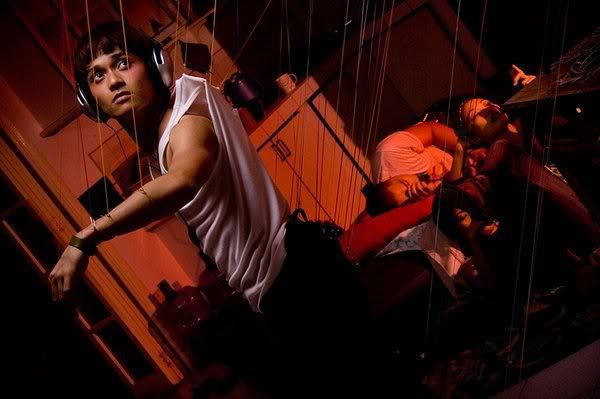
Mr. Salvarita, on the other hand, is a member of a family of artists based in Bacolod, but is now based in Dumaguete City and Bali, Indonesia. He graduated with a bachelor’s degree in Mass Communication at Silliman University, where he also later pursued a master’s degree in Environmental Policy. Razcel, perhaps Dumaguete’s fast-rising young visual artist is also a writer, a photographer, a performance artist, an environmental activist. He is best remembered as the person whose body was painted white and then who walked around Dumaguete semi-naked to call attention to his “Save the Balinsasayao Twin Lakes” campaign. He has also founded the collective art group Artantrum.

On
16 July 2010, each one will present a suite of three performances, alternating with each other. The combined work, titled
Russ/Raz: A Duet in Performance Art, is sponsored by the Silliman University Cultural Affairs Committee, and will be performed at the Claire Isabel McGill Luce Auditorium Lobby at 6:00 PM.
It is open to the public, and they are prepared to blow our minds with this duet of strangeness involving body and time and space and us, the spectators.
Labels: art and culture, cultural affairs committee, dumaguete, negros, performance art, silliman
[2] This is Where You Bite the Sandwich
 1:00 PM |
Acclaimed Rondalla Groups Invade Silliman
1:00 PM |
Acclaimed Rondalla Groups Invade Silliman
Two rondalla groups will perform in a rare full day of rondalla performances at Silliman University’s Claire Isabel McGill Luce Auditorium. The acclaimed Celso Espejo Rondalla and the La Libertad Children’s Rondalla are slated to do back-to-back performances on 17 July 2010, Saturday.
The Celso Espejo Rondalla, who will give a matinee performance at 3 PM and a gala performance at 8 PM, is composed of two generations of outstanding rondalla players: the senior members are professionals in their chosen fields while the younger ones are college students. The members were winners in the National Music Competitions for the Young Artists (NAMCYA), either as a solo instrumentalist or members of rondalla ensembles.

The group, named after Maestro Celso Espejo, the group’s conductor and one of the pillars of the Philippine Rondalla, was one of the performers in Cuerdas nin Cagabsan: The 1st International Rondalla Festival in Naga and Legazpi Cities, where they made an outstanding performance of light classics and contemporary Filipino compositions for rondalla. It was also one of the crowd favorites in Cuerdas Sa Panaghiusa: The 2nd International Rondalla Festival in Dumaguete.
The La Libertad Children’s Rondalla, on the other hand, will perform twice in the morning, at 8:30 and 10 A.M. This show is part of the Silliman University Cultural Affairs Committee’s outreach program, with this show designed specifically for children.
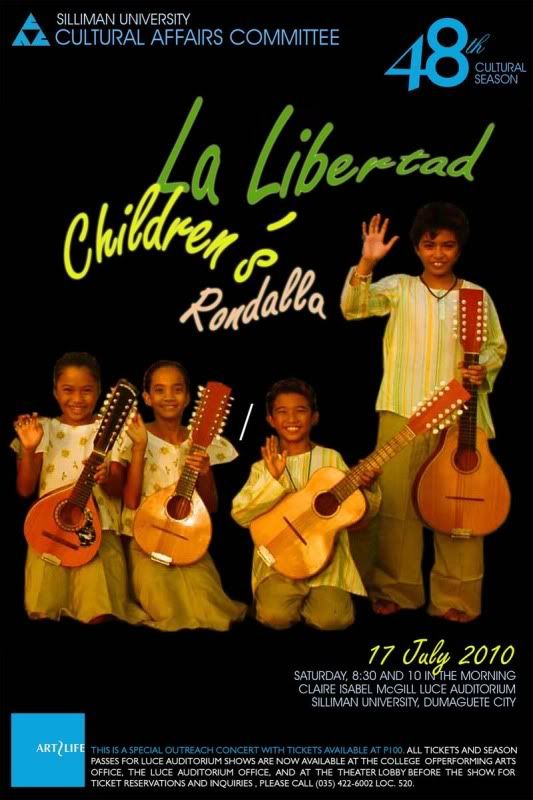
A fast-rising cultural act from the municipality of La Libertad, the group started when the town became a recipient of a set of rondalla instruments donated by the Provincial Government of Negros Oriental through Board Member Mariant E. Villegas. Then La Libertad Mayor Jocelyn Sy-Limkaichong, now the First District Representative of Negros Oriental, initiated the rondalla training program when she invited Mr. Ian Encarnacion, a voice major in Silliman University and a member of Kwerdas de Negros, to initiate a musical group in the town of La Libertad. The move sprang from Rep. Limkaichong’s vision to preserve local culture and revive an interest in Filipiniana.
Most of the members of the group are elementary school children, from grade four to five of Pio Banogon Elementary School.
Tickets for the Celso Espejo Rondalla Concert are available at P200 for the matinee and P300 for the gala show. Tickets for the La Libertad Children’s Rondalla are available at P100. For inquiries, please call (035) 422-6002 LOC. 520 or 09173235953.Labels: art and culture, cultural affairs committee, music, negros, silliman
[0] This is Where You Bite the Sandwich
GO TO OLDER POSTS
GO TO NEWER POSTS

















 8:44 AM |
Why Can't I Own a Canadian?
8:44 AM |
Why Can't I Own a Canadian?

 5:56 PM |
Happy.
5:56 PM |
Happy.
 1:21 PM |
Sliver
1:21 PM |
Sliver
 7:46 PM |
Amihan Explores Femininity and Power in New Art Exhibit at Silliman
7:46 PM |
Amihan Explores Femininity and Power in New Art Exhibit at Silliman



 1:48 AM |
Eating Pink Halo-Halo
1:48 AM |
Eating Pink Halo-Halo










 2:04 PM |
A Duet in Body and Imagination
2:04 PM |
A Duet in Body and Imagination



 1:00 PM |
Acclaimed Rondalla Groups Invade Silliman
1:00 PM |
Acclaimed Rondalla Groups Invade Silliman

